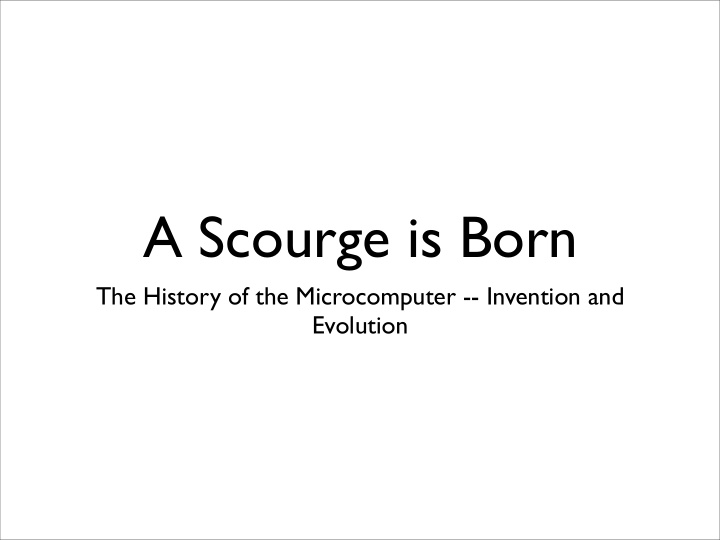



A Scourge is Born The History of the Microcomputer -- Invention and Evolution
Intel • 1968 - Intel is born out of Fairchild Semi. • Is an early leader in DRAMs • 1971 - Introduce 4004 • 1972 - Introduces 8008 • 1974 - Introduces 8080 • 1978 - Introduces 8086 • DRAMs become commoditized • 1983 - They shift to processors because there’s more money in it.
Intel • World’s largest semi-conductor manufacturer • Technology leader • Really a manufacturing company • With a tiny piece of architecture on top
The 0404 • Born out of necessity. • A customer wanted a calculator • Intel couldn’t design a bunch of controllers • But they could supply custom memories (i.e., they could store programs!)
0404 Features • A call stack -- because code lived in a ROM • Previous calling conventions overwrote parts of program memory • Intelligent memory chips. • Snooped a bus looking for commands • 16 pin packaging. • This was a real constraint
0404 Legacy • The first single-chip processor • An important exercise in reductionist computing • Follow on products are everywhere. • 8048 integrated ROM and RAM into one chip • Found use in > 1 Billion keyboards
The 8008 • This is a real computer • Programs in RAM • 16KB of memory • Vastly more expensive • 40 auxiliary chips • 2 more pins!!! huzzah!
And so it began... • Even at the beginning x86 was legacy. • Other horrors • Little-endianness • Complicated register rules • Segments • M. Shima perhaps deserves “credit” for x86
Technology • DRAM in the CPU • SSI vs. MSI vs. LSI • Interesting gap in capability between SSI and MSI • TTL was scalable but expensive • MSI was cheaper but not scalable • Leads to a huge gap in capabilities/$
Closing the Gap • Systems with more components • “Minis” “super minis” “main frames” • Systems with fewer components • “micro” “personal” etc. • There’s a clear migration of architectural features from “big iron” to “the desktop”
In context • This was the start of the industry that architects study. • We don’t pay much attention to mainframe (for better or worse).
Intel’s 3T memory cell 1970 1972
Recommend
More recommend